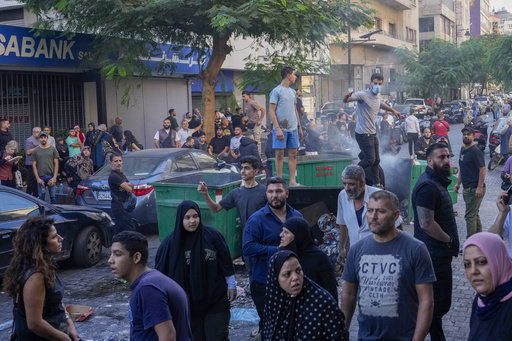
In a once-vibrant cinema in Beirut, groups of Lebanese, Palestinians, and Syrians, who have fled the ongoing conflict involving Israel and Hezbollah, now fill the space. They pass their time staying updated on news via their phones, cooking meals together, engaging in conversations, and taking leisurely walks to alleviate the monotony of their situation.
Outside the cinema, Hamra Street, which used to be a bustling commercial center, is now lined with individuals seeking refuge. Both hotels and residential apartments are packed with those displaced by the turmoil, while nearby cafes and restaurants are bustling with customers.
The large-scale displacement of individuals from southern Lebanon, the eastern Bekaa Valley, and Beirut’s southern suburbs has unexpectedly revitalized this area economically, which has suffered from stagnation due to Lebanon’s long-standing economic troubles. However, the resurgence is far from the revival many had anticipated.
“The displacement brought activity to Hamra Street, but not in a positive way,” shared the manager of a local four-star hotel, who opted to remain unidentified to discuss the escalating issues arising from the sudden influx of people. Initially, during the initial weeks of heightened conflict in mid-September, his establishment saw complete occupancy. Currently, occupancy has decreased to approximately 65%, which is still relatively strong for this season, as some have sought more affordable housing options.
However, he noted that this unprecedented movement of people has contributed significantly to disorder in the area. Normalcy has been disrupted by heavy traffic, illegal parking, and scooters cluttering the sidewalks, complicating pedestrian movement. The manager also mentioned that tension often flares between the permanent residents and the newly displaced individuals.
Hamra Street has historically been a reflection of Lebanon’s shifting political landscape. During its peak in the 1960s and early 1970s, it was synonymous with glamour, hosting premier movie theaters, vibrant cafes visited by artists and intellectuals, and upscale shops. Over the decades, it has experienced various phases of decline and revival, often mirroring the turmoil in Lebanon, including the civil conflict that lasted until 1990 and the Israeli invasion in 1982.
In recent times, the district has been heavily impacted by a surge of Syrian refugees escaping the war in their homeland, further complicated by a financial crisis in Lebanon that began in 2019. Following a dramatic uptick in hostilities that began on September 23, Israel targeted numerous locations in Lebanon, resulting in the deaths of nearly 500 individuals and injury to 1,600 in a single day. This escalation prompted a mass flight from the bombardments, leaving many seeking refuge in public spaces, such as parks and beach areas throughout Beirut.
According to the Health Ministry in Lebanon, over 2,574 people have lost their lives, and more than 12,000 have been injured over the past year of conflict, with approximately 1.2 million individuals displaced from their homes.
Many of these displaced individuals have gravitated towards Hamra, attracted by its cosmopolitan nature, some moving in with friends or family, while others flock to hotels or school buildings repurposed as temporary shelters. Recently, numerous vacant buildings have been occupied by overflow individuals seeking shelter, only to be evicted by security forces following sometimes violent confrontations.
Mohamad Rayes, a member of the Hamra Traders Association, indicated that prior to this influx, several businesses were contemplating closure due to financial struggles. “No one could have imagined this,” he remarked regarding the significant unexpected boost to commerce in Hamra. Some store owners have even doubled their prices in light of the increasing demand for goods.
Foot traffic has increased significantly, with local merchants like Farouk Fahmy observing a 70% spike in his sales during the initial two weeks post-influx, as newcomers particularly sought chargers and internet data to stay informed about current events. However, he noted that the initial excitement in the market has since reverted to stagnation.
Hani, a boutique owner who chose not to disclose his full name for privacy, reported a 300% surge in sales of essential items such as underwear and pajamas, as many displaced individuals left their homes with merely the clothes on their backs.
Meanwhile, Le Colisee, a 60-year-old cinema that experienced over two decades of closure, recently underwent renovations led by actor Kassem Istanbouli, who transformed it into a shelter for families escaping southern Lebanon. Istanbouli, who also operates theaters in Tyre and Tripoli, has opened all three venues to provide refuge to displaced individuals, regardless of their nationality.
In the shelter at the Beirut cinema, displaced families sit on thin mattresses on its once lavish red carpet, engaged in reading and monitoring their phones. Some offer help with the theater’s ongoing renovations. Among them is Abdul-Rahman Mansour, a Syrian man with his brothers and their Palestinian-Lebanese mother, Joumana Hanafi, who recounts fleeing Tyre after a nearby rocket attack.
After briefly staying at a school in Sidon, they were asked to leave due to their Syrian nationality and returned to Tyre for a single night, which Hanafi described as terrifying due to the intensity of the bombing. Contacting Istanbouli, they identified themselves as Syrians, only to be met with empathy; “It’s a shame you have to say that,” he remarked in solidarity.
Spending countless hours at his theaters in Beirut and Tripoli, Istanbouli maintains close connections with the individuals taking shelter there. “In the past, people came here to enjoy a movie, but now we all are here amidst the film that is unfolding outside,” he lamented, referring to the ongoing conflict.
